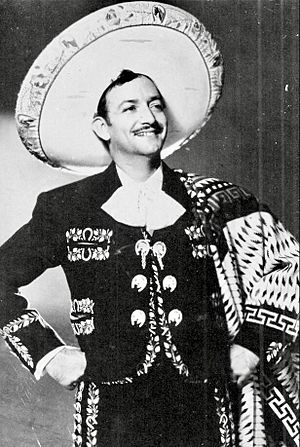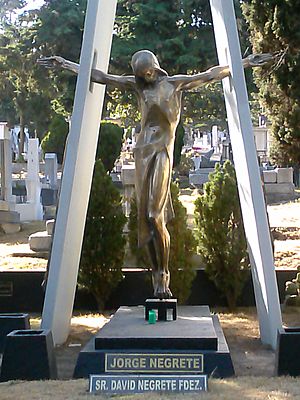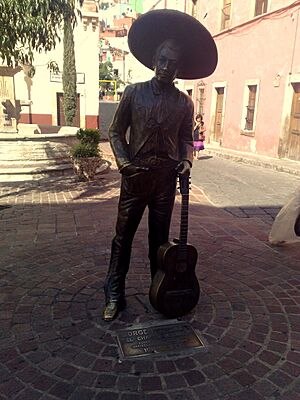Jorge Negrete facts for kids
Quick facts for kids
Jorge Negrete
|
|
|---|---|

Negrete, c. 1940s
|
|
| Born |
Jorge Alberto Negrete Moreno
30 November 1911 Guanajuato City, Mexico
|
| Died | 5 December 1953 (aged 42) Los Angeles, California, U.S.
|
| Occupation | Singer, actor |
| Years active | 1930–1953 |
| Spouse(s) |
Elisa Christy
(m. 1940; div. 1942) |
| Children | 1 |
Jorge Alberto Negrete Moreno (born November 30, 1911 – died December 5, 1953) was a very famous Mexican singer and actor. He was known for his strong voice and charming personality. Many people loved his movies and songs, especially his ranchera songs. He became a big star during the "Golden Age" of Mexican cinema.
Life and Career of Jorge Negrete
Jorge Negrete was born in Guanajuato City, Mexico. He had two brothers and three sisters. When he was young, his family moved to Mexico City. There, his father became a math teacher. Jorge and his brother David went to a German school, where they learned to speak German very well. Jorge also learned English, French, and Italian at a military academy. He was a very smart student and learned quickly.
When Jorge was thirteen, his father enrolled him in the military academy, called El Colegio Militar. He graduated as a sub-lieutenant. It was here that he discovered his love for music. His military training also helped him develop a strong and gallant presence, which was perfect for his future acting career.
Jorge met a famous singing teacher named José Pierson. Mr. Pierson was amazed by Jorge's voice and helped him train for opera. By the time he was twenty, Jorge was singing on the radio.
In 1932, Jorge went to the United States. He recorded several opera songs using the name Alberto Moreno. He also worked with famous musicians like Xavier Cugat. He performed in Latin clubs and met his first wife, dancer Elisa Christy. He also met a filmmaker named Ramón Peón, who gave Jorge his first movie role in La Madrina del Diablo (The Devil's Godmother) in 1937. After that, he made many more films.
Jorge Negrete was married twice, both times to famous actresses he worked with. His wives were Elisa Christy and María Félix. He also made many movies with Gloria Marín. She co-starred with him in ten of his films.

After working in Havana, Cuba, and Hollywood, Jorge Negrete returned to Mexico. In 1941, he starred in the movie ¡Ay, Jalisco, no te rajes! (Hey Jalisco, Don't Back Down!). This movie made him a huge international star. It also helped create the popular charro (Mexican cowboy) film genre. While filming, he met Gloria Marín, and they made many movies together.
Besides acting, Jorge Negrete also sang ranchera songs with a group called Los Tres Calaveras. He toured all over Latin America, performing concerts and meeting his fans. He was offered a main role in the movie El Peñón de las Ánimas (The Rock of Souls). He wanted Gloria Marín to be his co-star, but a new actress named María Félix got the role instead. Even though they didn't get along at first during filming, María Félix later became his wife.
Jorge Negrete was also an important leader of the Mexican National Association of Actors (ANDA), which is a union for actors. He became the chairman after Cantinflas. In 1952, there was a disagreement within the union involving an actress named Leticia Palma. Jorge Negrete believed she should be removed from the union. After a special meeting, the members voted to remove her, which ended her film career.
Death and Legacy
In 1953, Jorge Negrete was on a business trip in Los Angeles, USA. He sadly passed away from problems related to a serious liver illness he had since 1937. He was 42 years old.
According to his wishes, his body was flown back to Mexico. Thousands of fans attended his funeral. They followed the hearse to the Panteón Jardín cemetery, where he was buried in the section for actors.
Jorge Negrete was one of the "Tres Gallos Mexicanos" (Three Mexican Roosters). This name was given to him, Pedro Infante, and Javier Solís, who were all very popular singers and actors. All three of them passed away within 13 years.
Every year on December 5, the anniversary of his death, fans still visit his tomb to honor "El Charro Cantor" (The Singing Cowboy). Television and radio stations often play his films and songs all day long. In 2011, Mexico and other countries celebrated 100 years since his birth with special concerts and events.
Family
Jorge Negrete's parents were Emilia Moreno Anaya and David Negrete Fernández. His family had a history of military service. His siblings were Consuelo, Emilia, Teresa, David, and Rubén.
Jorge had one daughter, Diana, with his first wife, Elisa Christy. He has five grandchildren: Déborah, Diana, Rafael, Liliana, and Lorenzo. Rafael and Lorenzo are also professional singers and use "Negrete" as their stage name.
His stepson was the actor Enrique Álvarez Félix.
Filmography
- El Rapto (The Kidnapping) (1953)
- Reportaje (Reporting) (1953)
- Dos tipos de cuidado (Two Careful Fellows) (1953)
- Hechos uno para el otro (Made for Each Other) (1953)
- Tal para cual (To each his own) (1952)
- Un Gallo en corral ajeno (The Rooster in the wrong Chicken house) (1952)
- Los Tres alegres compadres (The Three Merry Pals) (1952)
- Hay un niño en su futuro (There is a child in your future) (1952)
- Siempre tuya (Forever Yours) (1952)
- Lluvia roja (Red Rain) (1950)
- La Posesión (The Possession) (1950)
- Teatro Apolo (Apollo Theatre) (1950)
- Una Gallega en México (A Galician in Mexico)(1949)
- Jalisco canta en Sevilla (Jalisco Sings in Seville) (1949)
- Allá en el Rancho Grande (Out On the Big Ranch) (1949)
- Si Adelita se fuera con otro (If Adelita went out with another) (1948)
- Gran Casino (great casino) (1947)
- El Ahijado de la muerte (Death's godson) (1946)
- En tiempos de la inquisición (In the Times of the Inquisition) (1946)
- No Basta ser charro (It's not enough to be a cowboy) (1946)
- Canaima a.k.a. El Dios del mal (The God of Evil) (1945)
- Hasta que perdió Jalisco (Until Jalisco lost) (1945)
- Me he de comer esa tuna Mexico (I have to eat this tuna) a.k.a. El día que me quieras (The day that you love me) (1945)
- Camino de Sacramento (Road to Sacramento) (1945)
- Cuando quiere un mexicano (When a Mexican loves) a.k.a. La Gauchita y el charro (The little [Argentinian] cowgirl and the [Mexican] cowboy) (1944)
- El Rebelde (The Rebel) (1943)
- Una carta de amor (A Love Letter) (1943)
- Tierra de pasiones (Land of Passions) (1943)
- Aquí llegó el valentón a.k.a. El Fanfarrón (here came the brave) (1943)
- El Jorobado a.k.a. Enrique de Lagardere (The Hunchback) (1943)
- El peñón de las ánimas (the rock of souls) (1942)
- Así se quiere en Jalisco (This is how One Loves in Jalisco) (1942)
- Historia de un gran amor (Story of a Great Love) (1942)
- Cuando viajan las estrellas (When Travel the Stars) (1942)
- Sed, sangre y sol (Thirst, Blood and Sun) (1942)
- Fiesta (party) (1941)
- ¡Ay Jalisco, no te rajes! (Jalisco, Don't Back Down!) (1941)
- Una Luz en mi camino (A Light on My Way) (1939)
- Juntos, pero no revueltos (Together, Not Mixed) (1939)
- El Cementerio de las águilas (The Cemetery of the Eagles) (1939)
- Juan sin miedo (1939) (Fearless John)
- Perjura (Perjurer) (1938)
- Caminos de ayer (Roads of Yesterday) (1938)
- La Valentina (1938)
- La Madrina del diablo (The Devil's Godmother) (1937)
- Cuban Nights (1937)
See also
 In Spanish: Jorge Negrete para niños
In Spanish: Jorge Negrete para niños



